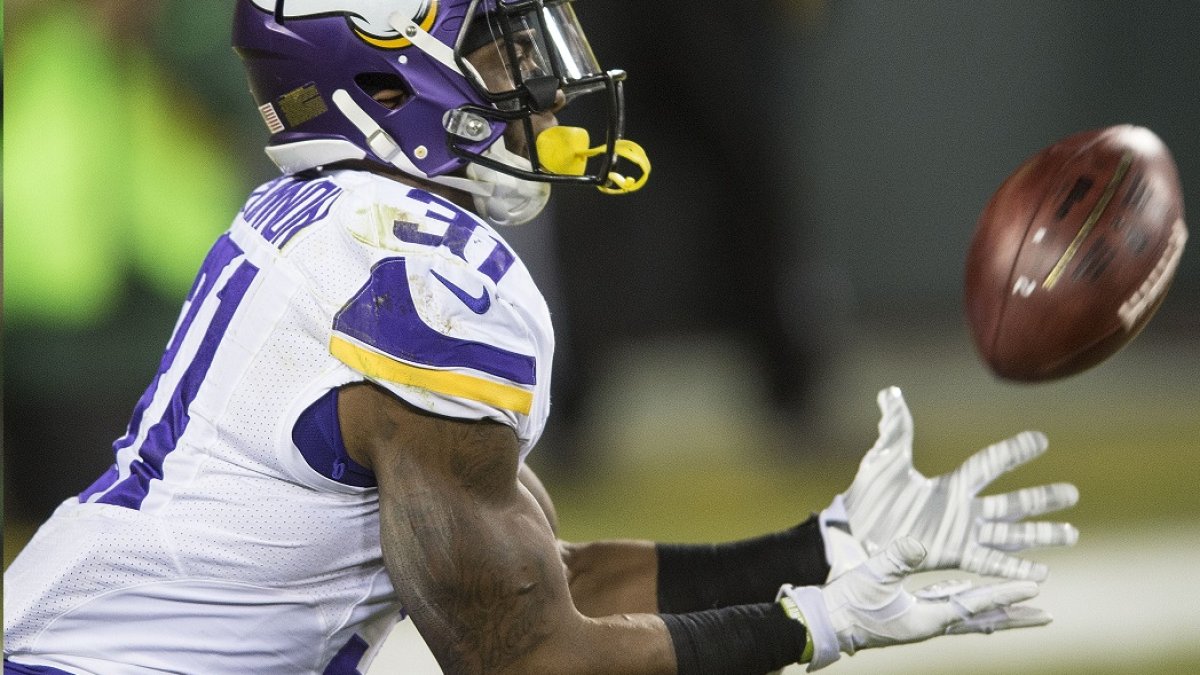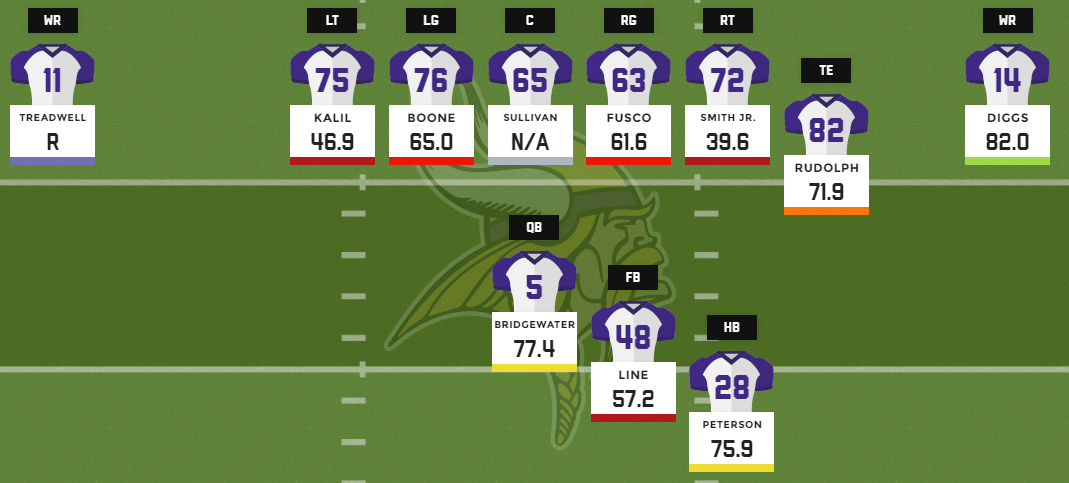(Editor’s note: As we lead up to the season, Director of PFF Fantasy Jeff Ratcliffe is breaking down each team’s depth chart from a fantasy perspective. Catch up on the work so far here.)
The Vikings are coming off an 11-win season despite having a limited offense that ranked 29th in total yards per game. But Mike Zimmer’s squad is chock full of young talent and moving in the right direction on the offensive side of the ball.
Entering his third season, Teddy Bridgewater had some buzz in fantasy circles as a popular breakout candidate at this time last year. Well, the breakout never came, and Bridgewater finished 24th among quarterbacks in fantasy scoring with just 14 touchdowns and 3,231 yards through the air. To be fair, he was operating in a run-heavy offense that threw just 51.1 percent of the time. He also had one of the league’s least-inspiring wide receiver groups. Bridgewater also proved to be very accurate despite seeing pressure on a league-high 46.7 percent of his dropbacks. The Vikings have a nice upgrade at wide receiver in rookie Laquon Treadwell, but it’s still tough to trust Bridgewater as a viable fantasy option until we actually see him get it done.
Speaking of Treadwell, the first-rounder enters the league as arguably the most polished receiver in this year’s class. He has prototype size (6’2, 210), but some will point to his poor testing numbers at the combine as a reason to not believe in the former Ole Miss receiver. But it’s important to remember that Treadwell suffered a nasty leg injury at the end of the 2014 season. Remarkably, he returned to play last season, and posted strong numbers including 17 forced missed tackles, which was fourth among draft-eligible receivers. Treadwell gives the Vikings the short and intermediate weapon they’ve lacked in Bridgewater’s first two seasons. He’s a good bet to lead the team in targets and should flirt with WR3 production.
Minnesota Vikings projected 2016 offense with 2015 grades:
Along with Treadwell, the Vikings will look to Stefon Diggs and Jarius Wright to round out three-receiver sets. Diggs burst onto the fantasy scene in Week 4 last year and proceeded to rack up 419 yards and two scores over his first four games. He cooled off from there, but still managed a respectable 720 yards on 52 catches. Diggs will likely take a back seat to Treadwell in the target pecking order, but he still offers WR4 value. In a more pass-heavy offense, Wright might be a viable option, but he’s off the fantasy radar in Minnesota.
At tight end, Kyle Rudolph remains cemented as the Vikings’ top option. He finished 14th in fantasy scoring last year, and that’s about his ceiling. From a production standpoint, he’s only topped 500 yards once in his career, and he isn’t a prominent red-zone asset despite being nicknamed the “red-zone reindeer.” A big part of the problem for Rudolph’s fantasy value is volume. Last season, he ranked 23rd among tight ends in targets. Expect a similar workload for Rudolph this year. His low ceiling is far from optimal for fantasy purposes.
Entering his age-31 season, Adrian Peterson is coming off an impressive 2015 campaign where he finished second in fantasy scoring and was the league’s lone running back to top 300 carries. He also forced the second-most missed tackles with 57 and had 17 runs of 15 or more yards. But Peterson has limited involvement in the passing game. Last year, he saw just 33 targets, and he doesn’t figure to see much more than that this season. While Peterson is still a clear RB1, minimal targets means a slightly lower weekly floor for Peterson than some of the other top-end fantasy options.
[Will Adrian Peterson be worth what he costs in drafts? What will it take to get Jerick McKinnon as his handcuff? Check out our PFF Draft Master tool and try a mock draft, complete with offensive line grades, full projections and all the PFF data.]
Minnesota will look to RB Jerick McKinnon in passing situations. The third-year man was one of the most productive fantasy scorers on a per-opportunity basis last season. He also averaged 5.2 yards per carry and posted the second-highest yards per route run (2.25) among running backs. McKinnon is expected to do more as a receiver this year, but his fantasy value will be limited as long as Peterson is on the field.
The Vikings are loaded on the defensive side of the ball with several IDP-relevant players. Everson Griffen has a combined 22.5 sacks over the last two seasons. He’s locked in as a DL1. Those in deeper leagues will also want to keep an eye on DE Danielle Hunter, who offers sack upside in Mike Zimmer’s defensive line rotation. Eric Kendricks didn’t play an every-down role until Week 8 last season, but he appears to be locked into those duties in 2016. He makes for an upside LB2 option. At safety, Harrison Smith is coming off an injury-plagued season where he finished a disappointing 46th among defensive backs in balance scoring. However, the Smith is poised for a rebound year following his big contract extension. He remains a DB1.



 © 2024 PFF - all rights reserved.
© 2024 PFF - all rights reserved.